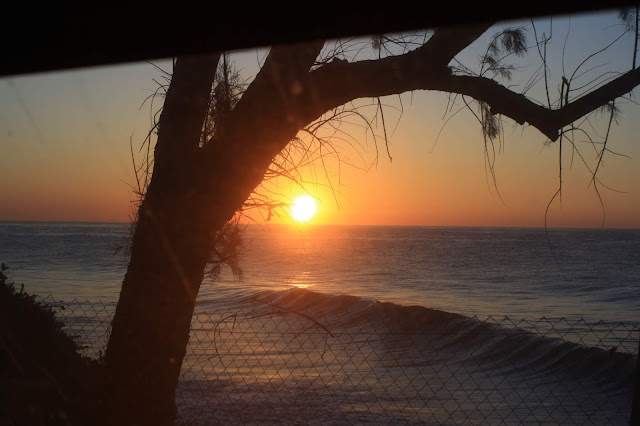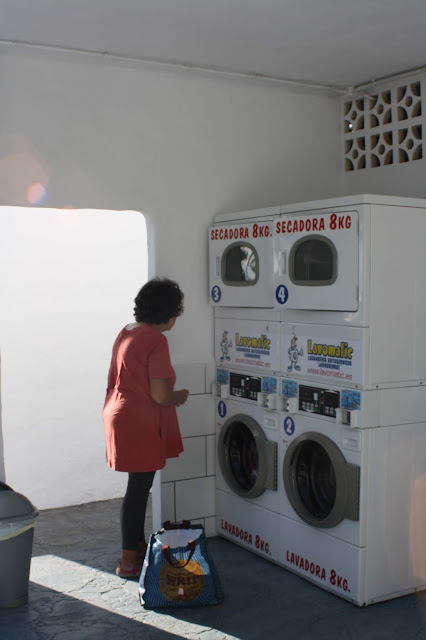So the plan was to spend a couple of nights at the campsite at Roquetas de Mar until the forecast winds died down then move on towards Almeria. When we reached Roquetas de Mar it looked dismal. The landscape shrink-wrapped as ever, but now embellished with clusters of industrial buildings - huge fruit distribution warehouses, truck parks and repair centres, snazzy looking 'Bio-tech' laboratories, all overlooked by giant advertising hoardings or big neon signs on a hundred foot high poles promoting golf resort real estate or discount deals on figure-hugging Lycra. It is only the fact that for over 300 days per year the sun shines and the sky shimmers wall to wall blue that saves this particular industrial sprawl from being just as grim as Walsall, Middlesbrough or Stoke-on-Trent.
The campsite is tucked away behind the tat about a kilometre from the coast. None of the roads to it are particularly straightforward, but we managed to pick the worst. In some failed attempt at jollification some enterprising urban planner had decided to build a central reservation down an already narrowish road, then plant trees on it. Their branches scraped along the side of the van as I edged along taking care not to hit the dry stone wall on the other side. After a couple of hundred metres of torture the pretence that the the road was two-way evaporated and we found ourselves on a single-track lane with Smart Car sized passing places. Dreadful.
We paused at the campsite gates, and agreed, no way. Gill plotted an alternative route back to the main road on her phone. It was better, but busy, through grids of apartment blocks and narrow streets lined with parked cars, then a few shops. Only later did we discover that we had driven straight through the middle of Aquadulce.
We decided to head to Camping La Garrota. Though it is only a few kilometres from the Roquetas de Mar sprawl, close to the main road and the A7 motorway, a mere ten minute bus ride from Almeria city centre, the place manages to feel a somewhat remote. It nestles in the only cove in a chain of vertical sea cliffs that divides the Roquetas de Mar conurbation from Almeria itself. We stayed here back in 2015 and remembered it with fondness as an interesting site, a little elderly but charming.
We decided to head to Camping La Garrota. Though it is only a few kilometres from the Roquetas de Mar sprawl, close to the main road and the A7 motorway, a mere ten minute bus ride from Almeria city centre, the place manages to feel a somewhat remote. It nestles in the only cove in a chain of vertical sea cliffs that divides the Roquetas de Mar conurbation from Almeria itself. We stayed here back in 2015 and remembered it with fondness as an interesting site, a little elderly but charming.
Most of the flat pitches behind the small beach are taken-up by folks here for the duration. Tourers end up in the terraced area nearer reception. Pitches are a tight squeeze for a 7m van, and getting level is a struggle, well actually with only two ramps it's impossible.
We took a short stroll down to the beach, photographed the old stone viaduct that cuts the site in half, reminisced that we had stayed before in the pitch underneath the arches, headed back and shared a beer.
"Well what's not to like here?" I posited rhetorically. A momentary silence....
Gill: We are on a bit of a wonk (bathroom door swings open of its own accord).
Pete: True, and the service point is tricky to reverse onto and has the third worst designed chemical toilet emptying point I have ever come across (as sewerage disposal engineer in chief he remembers these things).
Next morning - Gill's shower is luke warm, mine lovely... following day... situation reversed
Then there's the WiFi, free, so good; but signal wafts about like a crisp packet in a squall, so slow one photo can take half an hour to upload...so bad.
Therefore, in truth there is quite a lot not to like here. So why would we come back? Indeed, why might we regard the places as one of the handful of sites where we could imagine ourselves staying for a few weeks, rather than our usual couple of days? Well Google reviewer 'Ivoryrainbow' puts it like this:
★★★★★ 3 months ago
Well said! Mr Rainbow. It's the mixture of the place itself and the kind of people it attracts that gives La Garroffa its charm. I just know that 'Ivoryrainbow' is not going to be some miserable old git wearing pressed shorts and gleaming white ankle socks and sandals. This is not to say that La Garrofa attracts only youthful alternative types, there are many retirees overwintering on the beach-side pitches. However I observed not one example of a man in socks and sandals but quite a few elderly males with grey pony tails wearing faded black tees sporting metal death-head logos. Not that I own one myself, nor even in my hippiest days was ever tempted to gather my curly blonde locks into a ponytail or wear a bandana. However, in some alternative universe I can imagine I might have done. Conversely, in no reality, virtual or alternative, utopian or dystopian can I ever conceive a different me wearing sandals and socks.
We ended up staying here four nights, longer than in most places. We needed a bolt hole to hide in during the windy weather. The place is a good hideaway as it nestles by the sea at the end of a steep valley protected by steep cliffs. A disused old viaduct cuts through the site. It carries the old route of the N340. carved out of the sheer rock walls. Sometime in the 1960s, judging from the concrete bridge outside the site gates, the road was upgraded and La Garrofa tunnel built. Though it is next to the campsite there is little road noise as a decade or two ago this too was supplanted as the main coastal highway by the A7 motorway. It leaps across the narrow valley on tall stilts a few hundred metres inland. One of the attractions of La Garrofa is though the beach itself feels slightly remote, the place is less than 15 minutes from Almeria city centre, the buses half-hourly and the fare only €1.35.
As for the beach itself, with the slightly ramshackle whitewashed old buildings behind the greyish sand, the rocky promontories at each end and the distant view of the dark hills of the Cabo de Gata across the bay, it all looks a bit Greek. Anywhere that looks a bit Greek is bound to lift the spirits. Whipped-up by the brisk breeze the white topped waves crashed into the steeply shelving shingle, each one making a satisfying scrunch.
As well as the endlessly fascinating pastime of wave watching, there is a beautiful view towards the Capo de Gata's chain of old volcanoes. Some landforms seem uniquely satisfying, their particular topography and geology conspiring to separate them from the immediate surroundings. The Lake District is like that, seen from across Morecambe bay or glimpsed from the M6 the unique craggy outline sings out from the rolling green Pennines that surround it.
The Cabo de Gata is like that too, the purplish grey volcanic mountains contrast with the beige desert nearby. Seen from across the sea from La Garrofa beach it is even more of an alluring prospect. It's one of our favourite places in Spain. We are heading there next week and the forecast looks great






























































